

Understanding Yoga for Dancers. By Katherine Moore of Dance Informa.
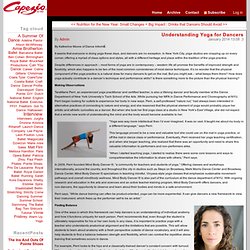
It seems that everyone is doing yoga these days, and dancers are no exception. In New York City, yoga studios are cropping up on every corner, offering a myriad of class options and styles, all with a different heritage and place within the tradition of the yoga practice. Despite differences in approach – most forms of yoga are in contemporary – western life all promise the benefits of improved strength and flexibility, which also happens to be two of the most common cornerstones of most dance techniques.
It’s no wonder that the physical component of the yoga practice is a natural draw for many dancers to get on the mat. Advanced Hip Flexor Stretching for the Hypermobile. First, I have to apologize for misleading you with the title. And for the record, the words advanced, stretching and hypermobile should never be used in the same sentence. That was just to lure you into reading this article. Muwhahaha…. Stop Stretching Your Hamstrings So Much. A few days ago I had an interesting conversation with a client of mine about body awareness.
IADMS. Balance, Proprioception & Alignment: On Stage & In The Dance Studio » 4dancers. September 6, 2013 in Editorial, Finding Balance Like this? Please share it! By Emily Kate Long You stand on a dimly lit stage. The murmur of the audience on the other side of the curtain swells and then settles. Ligament Pathologies in Dancers- Things You Need to Know. I also could have titled this blog post, “Getting My Geek On With the Postural Restoration Institute“, as that is where I spent this past weekend geeking out, and inspired what I’m writing about today. I had the pleasure of attending a Postural Restoration Institute course- Myokinematic Restoration, a course addressing issues of the lumbo-pelvic-femoral variety (so hips and pelvis mostly). This is a course that’s been on my wishlist for over a year now, so I was pretty stoked to be there.
What is the Postural Restoration Institute, and what do they teach? Long story short (very, very short), the PRI is big on the getting the body as symmetrical as possible (which is kind of impossible), because life tends to take us farther from symmetrical than is optimal. The more asymmetrical your body gets, the more dysfunctional too, which can lead to pain and crappy movement qualities. Along with an overdose on functional anatomy, I got some answers to questions like, Ligament Pathologies in Dancers- Things You Need to Know. Is it hard to teach turn-out? Is pedagogy difficult to learn and implement with American students?
Dance/USA — The national service organization for professional dance. One goal of the Task Force is to serve as a resource regarding issues of health and wellness for the professional dancer.
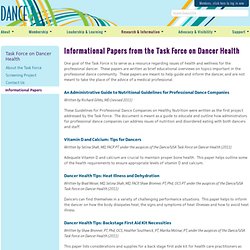
These papers are written as brief educational overviews on topics important in the professional dance community. These papers are meant to help guide and inform the dancer, and are not meant to take the place of the advice of a medical professional. An Administrative Guide to Nutritional Guidelines for Professional Dance Companies Written by Richard Gibbs, MD (revised 2011) These Guidelines for Professional Dance Companies on Healthy Nutrition were written as the first project addressed by the Task Force. Vitamin D and Calcium: Tips for Dancers Written by Selina Shah, MD, FACP PT under the auspices of the Dance/USA Task Force on Dancer Health (2011) Adequate Vitamin D and calcium are crucial to maintain proper bone health.
Dancer Health Tips: Heat Illness and Dehydration Dancers can find themselves in a variety of challenging performance situations. Kropp som en karamell. Pianist Tina Margareta Nilssen forklarer ved hjelp av en smakfull, trelags karamell hvilke funksjoner i kroppen som er viktig for en musiker.

Publisert 05.02.2014 kl 12.42 Oppdatert 21.03.2014 kl 10.03. Understanding Your Fascia. You've got this injury you just can't shake.You take time off.
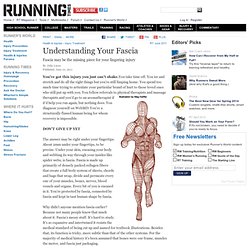
You ice and stretch and do all the right things but you're still limping home. You spend too much time trying to articulate your particular brand of hurt to those loved ones who still put up with you. Mind-Body Awareness in Dance, Part 1: Managing Overtraining. Today’s (and tomorrow’s) blog theme is the mind-body connection.
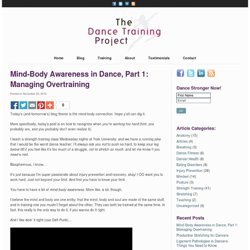
Hope y’all can dig it. More specifically, today’s post is on how to recognize when you’re working too hard (hint, you probably are, and you probably don’t even realize it). I teach a strength training class Wednesday nights at York University, and we have a running joke that I would be the worst dance teacher: I’ll always ask you not to push so hard, to keep your leg below 90 if you feel like it’s too much of a struggle, not to stretch so much, and let me know if you need a rest. Blasphemous, I know… It’s just because I’m super passionate about injury prevention and recovery, okay! You have to have a bit of mind-body awareness. I believe the mind and body are one entity; that the mind, body and soul are made of the same stuff, and in training one you mustn’t forget about the other.
Upper Trapezius Pain - Trapezius Strain. Does your upper back ever feel tight, as though you have “knots” in it?

The Best Kept Secret: Why People HAVE to Squat Differently. Video Addendum added 1/11/14 There is absolutely no one size fits all squat position.
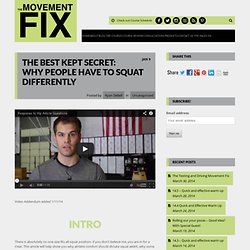
If you don't believe me, you are in for a treat. This article will help show you why athlete comfort should dictate squat width, why some people's (not EVERYONE) feet point out (no matter how much "mobility" work they do), why some people have a really hard time squatting deep, and why some people are amazing at pistols while others can't do them at all. The hip joint is basically made up of a "socket" on the pelvis (called the acetabulum) and a "ball" at the top of your thigh bone (femur), which we call the femoral head.
Around the hip joint are a lot of muscles, a joint capsule, and connective tissue. The Diaphragm Is A Muscle – Stretch And Strengthen It! By Louis Jackson, an Integrated Yoga Tune Up Instructor. Fitness for dance...not dance fitness. For sedentary individuals, taking up dance as a hobby or a past time can undoubtably have a positive effect on their overall health, fitness and well being, just as taking up any physical discipline can have a positive effect. Movements such as Zumba, aerobics, Jazzercise etc are all forms of dance fitness; as well as the plethora of community dance classes across a range of disciplines. While great at getting otherwise sedentary individuals into physical exercise, dance fitness has no relevance to the dance professional. As far as physical fitness goes, for the professional (or preprofessional) dancer, dance training alone is not enough. If you are serious about your dance performance you should get fit in order to dance, not dance to get fit.
This means training outwith your technique and performance classes, to prepare the body for the demands you throw at it.